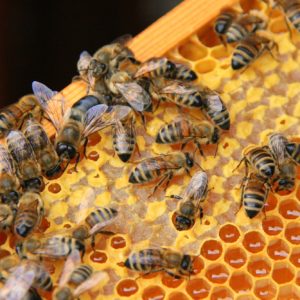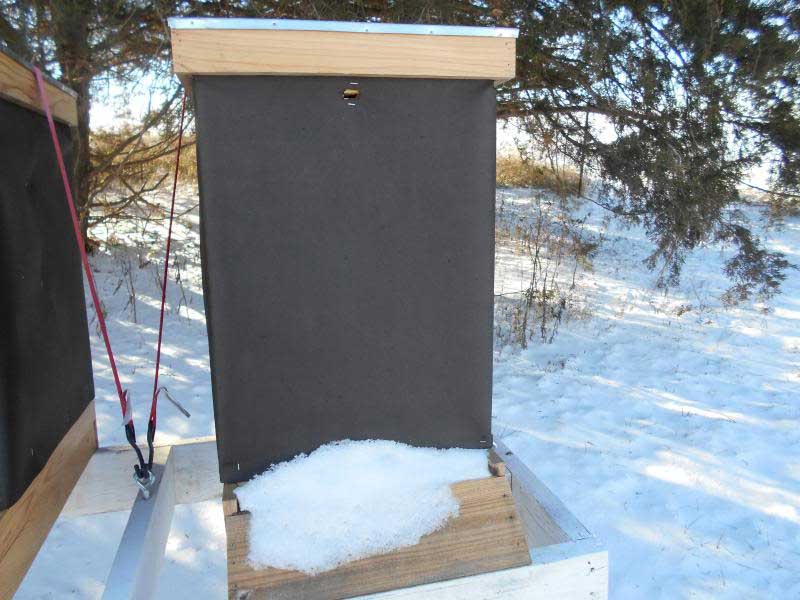The honey season has come and gone. Your honey is shining enticingly in bottles. Your hives still need some attention, however. This is the time to begin preparing your bees for winter.
Here is a handy checklist to help prepare the hive for winter:
- Varroa Mite treatment
- Liquid syrup for feeding when weather is still warm
- Candy board super
- Quilt board
- Hive wrap
- Entrance reducer
- Mouse guard
- Screen bottom board closed off with mite board
- Good Location
Remember: DO NOT OPEN YOUR HIVE IN WINTER

Varroa Mite Treatment: Your mite treatments should be complete by the beginning of November. The time to start your mite treatment will depend on the method you use. Keep in mind that the bees that will winter over in the hive will begin to hatch in September. It’s best to ensure that those bees are as mite free as possible. Consider beginning your mite treatment at the beginning of September. Some mite treatments are strips that need to remain in the hive for 45-56 days, and require removal from the hive when that time frame is up.
Take weather into consideration when you choose a method. If you have to open your hive to remove strips you need to make sure that it is not going to be too cold at the end of the treatment. In preparing bees for winter plan ahead. Also, PLEASE, this is important, if you use a mite pesticide that says to remove after a certain time frame, be sure to remove it. If it is not removed this gives the mites an opportunity to become resistant to the product.
Consider supplemental feeding in preparing bees for winter and cooler temperatures.
Syrup: Feeding your bees is something to consider. Until the weather becomes too cold syrup is recommended. This gives your bees an extra opportunity to store food for winter. A simple syrup made with two parts sugar and one part water will work, but there is also a commercially prepared syrup for sale here at Deseret Hive Supply. It not only provides nourishment but probiotic minerals as well. A supplemental syrup helps keep the bees healthier.

Candy Board Super: We highly recommend a candy board super. A candy board does three things. It provides food for your bees when they run out of their own food stores. As well as feeding, it provides insulation at the top of the hive, which is where most of the heat is lost as it rises. Absorbing extra moisture in the hive, it also protects bees from too much condensation. This is made ahead of time and ready to install for the colder temperatures. Planning a good time to install your candy board super is essential. It goes at the top of your hive, just under the lid and inner cover. If it is too cold outside when you do this all of the heat that your bees have generated will be lost. Consider the weather before proceeding.
The recipe for the candy board super can be found in the recipe section of this blog.
Quilt Board: Making a quilt board for your hive provides an extra layer of insulation at the top of the hive. This will keep heat from escaping the hive. It will absorb extra moisture, which keeps condensation from dripping on the bees and freezing them.
Tar paper is used to help the hive absorb the heat from the sun.
Hive Wrap: A hive wrap is a nice way to help prepare bees for winter and keep the hive warm. There are many materials that can be used to wrap your hive. Tar paper is used to help the hive absorb the heat from the sun. If your hive is located in a sunny place tar paper is a good choice. Insulation can be placed around the hive. Insulation keeps the heat that the bees generate from escaping. Materials to avoid would be anything that would make the hive air tight. For example: do not wrap the entire hive in plastic. The hive needs to breathe. Never block the entrance of the hive and be sure to make the entrance accessible.

Entrance Reducer: I recommend reducing the entrance for winter, or better yet, as soon as you remove your honey super. In the fall all bees, ie. wasps, hornets, yellow jackets etc., are preparing for winter. They are not above stealing from other hives to accomplish their goals. This is an important time to reduce the entrance of the hive so your guard bees don’t have to work as hard to protect the hive.
Mouse Guard: In addition to an entrance reducer, you may want to consider a mouse guard. Mouse guards are usually made of metal, so mice can’t chew through them, and they have holes in them that are large enough for bees to travel through but too small for mice to get through. If your hive is in or near a field or orchard I highly recommend using a mouse guard.
Screened Bottom Board: If your hive has a screened bottom board you will want to close off the screen for winter. You can do this by simply sliding in your varroa inspection board.
Never block the entrance of a hive and be sure to make the entrance accessible.

Location: Think about the location of your hive. The perfect place for the hive in the summer time might not be a good place in winter. If you have the option of moving it, consider doing so. Full sunshine in the winter is great. Protection from wind is important. Placing the hive in front of a south facing wall provides extra warmth. Moving a hive in the winter is a simple option.
Placing the hive in front of a south facing wall provides extra warmth.
Remember: Do Not Open Your Hive In Winter!
Once your bees are all tucked in for the winter you don’t want to open the hive. Keep the entrance clear of snow and other obstacles, so the bees can exit and enter the hive.
Winter is a hard time for bees. They stay warm by clustering close together and vibrating their wing muscles. This produces heat. They move around the hive to new sections of honey which they consume for energy. Do everything you can to help them survive and they, and you, will be happy in the spring.
Annessa Bachman – Manager, Professional Beekeeper

Thank you thank you thank you for this reminder. It is very helpful and informative at such a busy time of the year for all that needs to be done in winter preparations in utah.